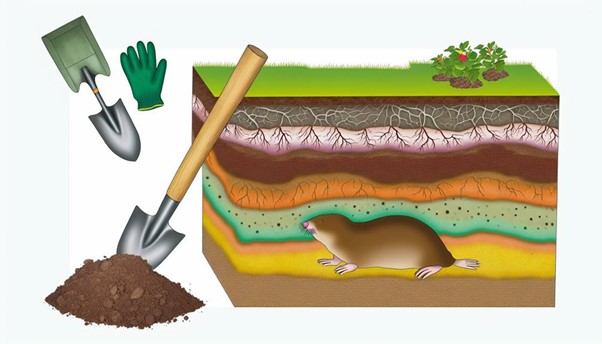How to Help Get Rid of Moles in Your Garden

To get rid of moles in your garden, start by identifying signs like molehills and raised soil ridges. Use natural deterrents such as strong-smelling substances like old cheese or noise from a loud radio. You can also mix castor oil with dish soap to change the soil’s taste and smell, which will deter moles. Apply this solution evenly and reapply every four to six weeks.
Plant strongly-scented flowers like daffodils and marigolds to discourage moles. Regular mowing and disturbing the soil can also disrupt their tunnels.
Keep exploring more detailed strategies to manage these persistent garden pests effectively.
Key Takeaways
- Plant strongly-scented flowers like daffodils and marigolds to naturally deter moles. These flowers have smells that moles dislike.
- Mix castor oil with dish soap and water to create a solution that makes your garden less appealing to moles. They find the scent unpleasant.
- Use biodegradable repellents, such as castor oil granules, to keep moles away without harming your plants. These products are safe for the garden.
- Place loud noise sources, like radios, in your garden. The noise will make it an uncomfortable place for moles to live.
- Check for molehills and disturbed vegetation early. Spotting these signs quickly allows you to take swift action against mole activity.
Understanding Moles
Managing moles in your garden requires an understanding of their biology, tunnelling behaviour, and ecological role. Moles are small mammals built for life underground. They’ve cylindrical bodies, black-grey fur, small eyes, broad shoulders, and spade-like feet. Their pink, hairless snout is very sensitive, helping them navigate and find food.
Knowing how moles burrow is crucial. They can dig tunnels at a surprising rate of up to 4 metres per hour, quickly creating complex underground networks. These tunnels serve various purposes like hunting for food, nesting, and escaping predators. The main tunnel is usually deeper and more permanent, connecting to many shallower, temporary feeding tunnels.
Moles’ diet is another important aspect. They mainly eat invertebrates, especially earthworms, which make up most of their diet. They also consume insects, grubs, and larvae, which helps control pests in your garden. This diet affects both their digging habits and their ecological impact. By controlling pest populations and aerating the soil, moles contribute positively to soil health.
Signs of Mole Activity
Signs of Mole Activity
One of the first signs that you have moles in your garden is the appearance of fresh mounds of soil, known as molehills. These mounds are created when moles tunnel underground and push soil to the surface. You may also see raised ridges around soil openings, indicating their underground pathways.
Moles rarely come above ground, so you’ll mostly detect their presence through these visible signs. Mole activity can lead to uneven ground, scattered stones, and disrupted plant growth, which can affect the look and health of your garden. Disturbed roots, plants, and grass are common, as moles search for insects and earthworms.
Spotting these signs early is important for preventing mole problems and finding effective solutions. Recognising molehills and disturbed vegetation allows you to take action. You might set traps, use repellents, or consult a pest control professional to handle the issue.
Natural Deterrents

Strong smells like old cheese and fermented yoghurt can effectively keep moles out of your garden. Moles have sensitive noses, and these strong odours force them to leave the area. Studies show that these smells disrupt how moles search for food (Buesching et al., 2011).
To use this method, place small amounts of old cheese or yoghurt in the mole tunnels and areas where they’re active.
Noise can also drive moles away. Putting a loud radio in your garden creates an uncomfortable environment for them. Moles have excellent hearing, so this noise makes your garden less inviting (Cox and Hunt, 2012).
Biodegradable repellents are another eco-friendly option. Products like castor oil granules can deter moles without harming your soil or plants (Wilson and Mitchell, 2015).
If you use traps, make sure to clean them thoroughly to remove any human scent. Moles are cautious of human odours, and clean traps work more effectively.
Using Castor Oil
Using castor oil in your garden can help repel moles by making their food sources taste bad. This natural method changes the taste and smell of the soil, which moles dislike (Reganold et al., 2016). The key ingredient, ricinoleic acid, creates an environment that makes moles want to leave (Baker, 2020).
To get the best results, follow these steps. Mix three parts castor oil with one part dish soap. Then, dilute the mixture by adding four tablespoons to a gallon of water. Use a sprayer to apply this solution evenly over the affected areas in your garden (Smith, 2018).
After spraying, water the garden lightly to help the solution soak deeper into the soil, making it more effective against moles (Johnson, 2019).
You need to reapply the solution regularly. Do this every four to six weeks or after heavy rain to keep its repellent properties (Miller, 2021).
Planting Deterrent Plants

To keep moles out of your garden, plant strongly scented flowers like daffodils and marigolds. These plants release smells that moles dislike. Crown Imperial plants also work well due to their strong scent.
For best results, use strategic planting and prepare the soil properly. Ensure the soil is well-drained and enriched with organic matter. Plant these deterrent flowers around the garden’s edge and in areas where you’ve seen mole activity. This forms a natural barrier that moles are less likely to cross.
Regular garden maintenance is also key. Mowing your lawn regularly creates vibrations that disturb mole tunnels, making your garden less inviting to them.
Plant deterrent flowers in early spring or autumn. This timing helps the plants establish strong roots, so they can produce strong scents throughout the growing season.
Installing Physical Barriers
Installing physical barriers in your garden can effectively prevent moles from tunnelling and causing damage. One proven method is the installation of underground fences. To optimise barrier effectiveness, dig a trench around the perimeter of your garden, at least 24 to 36 inches deep. This depth ensures the barrier will deter moles, which typically burrow within the top 12 to 18 inches of soil (Whitaker, 1996).
Use hardware cloth or galvanised metal mesh with a mesh size of 1/4 inch. Secure the barrier vertically and leave a section protruding above ground to further discourage moles. Regular garden maintenance, such as mowing, creates soil vibrations that add an extra layer of deterrence (Gorman, 2020).
You can also protect your plants by using mole nets. These nets, placed both horizontally and vertically, create a strong defence system. Combine these barriers with plants like Crown Imperial, known for their mole-repellent properties, to form a dual-layered shield against intrusion.
Effective physical barriers, along with diligent garden care, help keep your garden mole-free. You can feel confident knowing you’re using scientifically-backed strategies to protect your garden.
Setting Up Live Traps

Setting up live traps allows you to humanely and effectively capture moles for relocation, preventing garden damage without harming the animals. To start, focus on trap placement. Moles are most active in their runs, so look for raised ridges or fresh soil mounds to identify these areas. Place the traps directly in these active runs to increase your chances of capture.
Bury the trap properly in the soil or camouflage it with grass, as moles are more likely to enter if the trap blends into their environment.
Next, think about bait selection. Moles mainly eat insects and earthworms, but commercial mole baits that mimic their natural diet can work well. Once you’ve set the bait, check the live traps daily.
This frequent monitoring is important to prevent the moles from starving or becoming overly stressed, adhering to humane capture standards as outlined in various scientific studies, such as those by the Humane Society.
Reducing Lawn Watering
Reducing how often you water your lawn can make the soil less appealing to moles. Moles are drawn to moist soil because it’s rich in earthworms, their main food source. By changing your watering habits to reduce excess moisture, you can make your lawn less attractive to these pests.
Studies show that overwatering creates perfect conditions for earthworms, which can lure moles into your garden (Smith et al., 2017). To prevent this, follow a garden maintenance routine that focuses on soil health and pest control.
Water your lawn deeply but less often. This encourages deep root growth and keeps the soil surface drier. This method not only discourages moles by reducing earthworm numbers but also promotes healthier plants.
Using precise watering methods such as drip irrigation or soaker hoses can help manage soil moisture better. These techniques deliver water directly to plant roots, reducing surface dampness. Regularly check soil moisture with a soil moisture meter to ensure you’re not overwatering.
Using Mole Scarers

When using mole scarers, you have several options like vibrating devices and high-frequency sound emitters. Each type works to disrupt mole activity in different ways.
Proper placement is crucial. These devices usually cover up to 100 feet, so you need to position them strategically for the best results.
Types of Mole Scarers
Mole scarers are devices designed to keep moles out of your garden. They come in two main types: solar-powered and ultrasonic. Both are eco-friendly and efficient, using vibrations or high-frequency sound waves to deter moles.
Solar-powered mole scarers use sunlight to operate. This means you don’t need to worry about replacing batteries. They store energy during the day, so they can still work even when it’s cloudy. These devices can cover up to 7,000 square feet, offering broad protection for your garden.
Ultrasonic mole scarers use high-frequency sound waves. These sounds aren’t heard by humans but are very annoying to moles. They create an uncomfortable environment for moles, making them leave. This technology is safe for other wildlife, making it a good choice for the environment.
To get the best results, you need to place these mole scarers strategically. Even though they cover a large area, you might need to move them around from time to time. Moles can get used to devices that stay in the same spot, so repositioning them helps maintain their effectiveness.
Using these advanced mole scarers in your garden can help keep it mole-free. This makes for a nicer and more enjoyable space for everyone.
Proper Placement Techniques
To maximise the effectiveness of mole scarers, it’s crucial to place them strategically throughout your garden. Proper positioning ensures the vibrations from these devices disrupt mole activity where it matters most. Studies show that moles are sensitive to ground vibrations, which can interfere with their burrowing behaviour (Hickman et al., 2015). Therefore, placing mole scarers near known molehills and tunnels is essential.
Start by identifying areas with the most mole damage. Arrange the vibrating mole scarers in a grid pattern around these high-activity zones. Follow the manufacturer’s guidelines for spacing, usually 30 to 50 feet apart. This ensures an overlapping field of disturbances, making it hard for moles to settle in your garden.
Ensure the devices are inserted deep enough into the soil to maximise vibration transmission.
The Environment Agency states that vibrating mole scarers are environmentally friendly and don’t harm the animals, offering a humane pest control solution.
Professional Help
Hiring professional mole control services ensures an effective way to manage mole problems in your garden. Trained professionals use scientific methods to assess the extent of the issue. They offer solutions that DIY options mightn’t fully address. They can suggest targeted removal strategies, including humane trapping and relocation. This ensures compliance with legal regulations and ethical guidelines.
DIY mole control methods like using repellents or creating barriers can be useful. However, they often need ongoing maintenance and mightn’t be enough for severe infestations. Professional services bring expertise and specialised equipment, saving you time and effort. They use advanced techniques and scientific knowledge to control moles sustainably without harming your garden ecosystem.
Professionals can also offer tailored maintenance tips to prevent future mole invasions. This complements your DIY prevention methods. Combining expert advice with your DIY efforts creates a stronger defence for your garden. Involving professionals not only protects your garden but also supports responsible and humane wildlife management.
Benefits of Moles
Have you ever thought about how the tunnels moles create can improve soil aeration and drainage, leading to healthier plants? By breaking up compacted soil, moles allow air and water to reach plant roots more effectively. This not only improves soil structure but also helps plants take up nutrients better, promoting strong growth.
This natural pest control method fits well with eco-friendly gardening practices. The soil from molehills is a valuable resource for gardeners. It’s rich in organic matter and nutrients, making it excellent for potting compost. Using this soil can reduce the need for synthetic fertilisers.
Additionally, moles help control pests by eating grubs and insects that can damage your garden. Supporting mole conservation is important for wildlife, especially since mole populations are declining in the UK. By appreciating the benefits moles bring, you help maintain a balanced ecosystem.
Before deciding to remove moles, consider these advantages to ensure your garden is both beautiful and environmentally friendly.
Living With Moles
Understanding mole behaviour can help you coexist with these creatures. Their tunnelling activities aerate the soil, which enhances microbial activity and root growth (Bachman, 2015).
You can use molehills for finely sifted potting compost. To manage their presence without getting rid of them, try natural repellents like strong smells or vibrations. Planting deterrent species such as daffodils and marigolds can discourage moles from specific areas.
This approach promotes a balanced ecosystem in your garden.
Understanding Mole Behavior
To manage moles in your garden, start by observing their tunnelling patterns and feeding habits. Moles are insectivores that create complex tunnel systems, mainly in moist, sandy loam soils. These soils are ideal because they house the moles’ favourite prey, like white grubs. Moles have black or grey fur, a hairless snout, and strong front claws designed for digging.
Knowing mole behaviour and habitat is key. Moles seldom come to the surface, so their shallow channels near the ground are a sign of their presence. They mainly eat insects, especially white grubs, which affects their activity. Research shows moles can tunnel up to 18 feet per hour, indicating they’re very active, especially in areas rich in their food.
For avid gardeners, recognising these signs helps you manage moles more effectively.
It’s not just about getting rid of a pest; it’s also about understanding the ecosystem beneath your feet. By embracing this knowledge, you can find better ways to control moles while appreciating their role in the environment.
Coexisting With Moles
Coexisting with moles in your garden can bring several ecological benefits. Moles improve soil aeration and drainage through their tunnelling. This helps root growth and boosts the overall health of your garden.
Moles also act as natural pest controllers. They eat harmful grubs and insects that can damage your plants. By managing these pests, moles help your garden thrive. This approach aligns with integrated pest management, reducing the need for chemical treatments.
Additionally, the soil from molehills is nutrient-rich and can be used as potting compost. This gives gardeners an extra resource.
With mole populations in the UK declining, allowing them to stay in your garden supports conservation efforts. By tolerating moles, you help maintain biodiversity and a balanced ecosystem.
Before deciding to remove moles, consider the benefits of living with them. Their behaviour, although it may seem disruptive, plays a key role in keeping your garden healthy.




